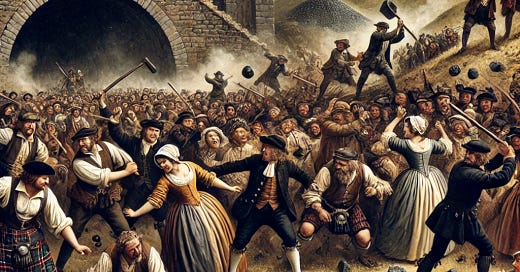In the peaceful landscape of 17th-century Bo’ness, tucked near the shores of the Firth of Forth, you wouldn’t expect a story this dramatic. But beneath the surface—literally—lay a drainage tunnel, or “levell”, that carried more than just water. It carried decades of rivalry, property rights, inheritance drama, and ultimately, violence.
In 1668, this conflict exploded between two powerful landholding families—the Wauchs of Grange and James Riddell of Kinglassie—over who controlled the right to maintain and use a long-forgotten underground coal drain known as the Caldwall Levell.
The result? One of the wildest and most unusual legal and physical battles in early modern Scottish history.
Act I: The Hidden Levell of Grange
The story begins with a piece of industrial infrastructure—a levell, or horizontal tunnel—that had been created decades earlier by the Bruce family, famous for pioneering coal mining technology in Scotland. This particular levell ran through a portion of land known as the Caldwall, part of the Grange estate.
Coal heughs (mines) at the time were often plagued by water, which would flood mine shafts and halt production. A properly placed levell would drain this water away, allowing miners to reach deeper seams. Whoever controlled the levell controlled the lifeblood of any surrounding coalworks.
Ownership and legal rights to the levell had become muddy over the years. By 1668, two parties laid claim to it:
Mr. John Wauch, minister of Bo’ness and new husband to Lady Christian Forrester, the widow of Sir James Hamilton of Grange, who had long held the land.
James Riddell, merchant of Leith and proprietor of the coalworks of Kinglassie, who argued that he inherited rights through a 1638 disposition from the Grange family.
What followed was anything but a polite land dispute.
Act II: Mud, Swords, and a Barricade
According to documents submitted to the Privy Council of Scotland in April 1668, Riddell had begun clearing and reopening the levell to drain his mines, which had been flooded for years.
Lady Grange, now backed by her husband Mr. Wauch, was having none of it.
She accused Riddell of “tumultuary violence”, sending in a team of oversmen, coall hewers, grieves, carters, and armed men to dig through her land without any warrant or court order. She showed up to confront them—peacefully, she said—with a few of her servants, only to be beaten and bloodied by Riddell’s men.
Riddell denied everything. In a counter-petition, he claimed that it was Lady Grange and Mr. Wauch who had blocked the levell illegally. And when he and his workers tried to reopen it, they were attacked by an armed mob that included Lady Grange, her daughters, salt workers, bellmen, officers, and even coal bearers—some of them women. According to him, they:
“Did in ane violent and hostile manner fall upon the said compleaner and his servants… with swords, staves, stones, and battons… by which rable… they were necessitate to flee for safetie…”
He added that over 500 stones were thrown during the altercation.
Act III: The Most Unlikely Army in Scotland
Perhaps the most extraordinary aspect of this coal-fueled clash is the composition of the “army” raised by Lady Grange and Mr. Wauch.
The names of those involved read like a full roll call of the Grange community: bellmen, officers, coal bearers, salt bearers, smiths, daughters, servants, and even a footman. Women made up a surprisingly active and violent portion of the fighting force, and Riddell’s complaint singles them out for their “cruel and unchristian” pursuit of his workers.
He noted that five or six women from the Wauch household chased his fleeing men, throwing hundreds of stones in what must have resembled a miniature battlefield on the normally quiet lands of the Caldwall.
Riddell claimed the conflict wasn’t just personal—it had broader economic stakes. Over 500 poor workers depended on his coalworks for survival. Without a functioning levell, the mines would flood again. In his words:
“The publick trade and commerce greatlie prejudged… and above the number of fyve hundreth poor persons… are in hazard to be starved and famished.”
Act IV: Justice or Ceasefire?
The Privy Council took the matter seriously. Both parties appeared personally before the council, which was a big deal. The matter was remitted to a commission made up of the Earls of Linlithgow and Kincairdin, who were given authority to:
Visit the levell and the Caldwall lands
Hear both sides
Examine witnesses under oath
Attempt to mediate peace or report back
And then—nothing.
There’s no further entry in the official minutes of the Privy Council. That silence suggests the Earls likely brokered a local agreement, perhaps forcing both families to withdraw their claims or share the levell.
In a way, that anticlimactic ending mirrors many real-world land disputes: fiery, intense, sometimes even violent—but quietly resolved off the record.
Legacy: What the Caldwall Conflict Tells Us
The Caldwall Coal War isn’t just a quirky historical episode. It’s a vivid microcosm of 17th-century life in Scotland, where:
Industrial technology (like water levels and drainage) was life-and-death
Landownership battles could spill into full-scale violence
Women played unexpected and prominent roles in public confrontations
The law was complex, often murky, and not always quick to decide
Ordinary communities lived on the edge of subsistence, completely dependent on successful coal production
It also gives us a unique peek into the emotional intensity of property, family legacy, and local pride in small Scottish towns like Bo’ness. This wasn’t just about coal—it was about control, respect, and who had the right to shape the land.





